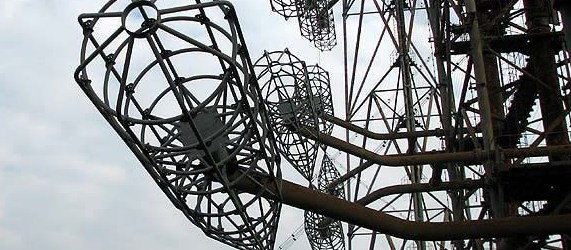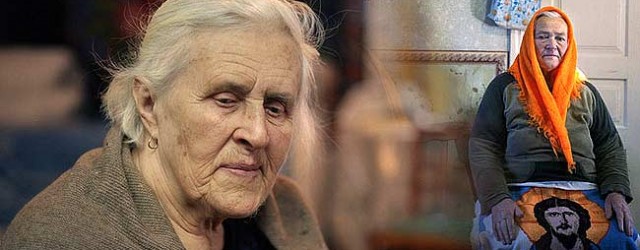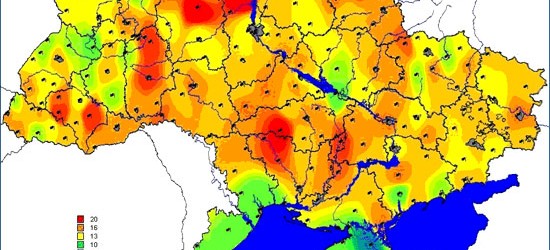
The city Chernobyl-2 is located northwest of the small town of Chernobyl in Polissia region of Ukraine, but it is impossible to find on any topographical map. Exploring the maps, you are likely to find a symbol for a children’s boarding house, or a dotted line of forest roads on a place of accommodation of the town, but no reference to urban and technical buildings. In the USSR, they were able to hide a secret, even more so if it was a military secret.
Only due to the collapse of the Soviet Union and the accident at the Chernobyl nuclear power plant did it become known of the existence of a small town (military garrison) in the Polissia woods which was engaged … in “space espionage.” In the seventies of the last century were created unique military radar systems to track ballistic missile launches from the territories (or military bases and submarines) of the likely opponent. The created radar system was named “Over-the-horizon radar station” (Duga-1). With its enormous size and receiving antenna masts, Duga-1 demanded a large human resource – approximately 1,000 people worked on the military alert status at the site. For the militarmen and their families, a small town with one street was built, named Kurchatov.
In the map below, one can see the urban infrastructure.
The layout of the Chernobyl-2 city infrastructure, prepared on the basis of site imagery and wikimapia.org.en, wikipedia.org.
The decision to create the “Over-the-horizon radar station” (Duga-1) (near the Chernobyl) was made under government orders dated January 18, 1972 and April 14, 1975
By 1976, the main radar site Chernobyl-2 was built. The general designer of the radar station in Chernobyl-2 was the Research Institute for long-distance radio communication (NIIDAR). Chief Designer and inspiration of the ideas for Duga-1 was Franz Kuzminsky.
The first tests of the radar by the State Commission occurred in 1979. As experts “… during preparations for the tests, it was necessary to solve some practical problems caused by circumstances of something absolutely new and unique, not having analogies in the world means …”
According to some sources – “… during the tests carried out to detect the launch of ballistic missiles and rocket carrier at Eastern U.S. missile test sites, checked the adequacy of models on the results of detection of associated launches of ballistic missiles and missile carriers of the U.S., which confirmed the correctness of the chosen model representations.”
However, shortcomings were found and the system had a lack of quality and single definition of goals and objectives for small groups. The hight-quality radar station work achieved only conditions for the massive strikes of ballistic missiles of the likely opponent.
Despite some functional limitations in 1982, according to the Resolution of the Government (on May 31, 1982), Chernobyl-2 was accepted into a trial operation. On the occasion of the acceptance into operation of the radar “Duga” (so-called military station in Chernobyl-2), the developers of the complex received state awards – VN Vasenev, BM Danilov, NF Dubrovsky, Y. Krokunov, etc.
Together with the radar station in Chernobyl, the USSR created two similar systems in the cities of Nikolayev and Komsomolsk-on-Amur. In the map from space, you can see how these Duga-1 facilities were controlled.
Radars cover territory – Duga-1 (Chernobyl-2 and Nikolaev) and Duga-2 (Komsomolsk-na-Amure)
With the beginning of operations at these complexes, additional problems occurred. It turns out that part of the working frequency range of the radar systems coincided with systems of civil aviation and the fishing fleets from European countries. The USSR received an official appeal from Western countries that the establishment of this system significantly affects the safety of aviation and maritime navigation.
The USSR conceded and stopped using the working frequency. Immediately before this, the designers were asked to address the deficiencies of the radar. Scientists and designers solved the problem, and after modernization, the system started again in 1985.
After the Chernobyl accident in 1986, the radar was removed from alert status, and equipment was disabled. Military and civilians were evacuated from the zone of radioactive contamination. When the USSR and the military leadership had understood the extent of environmental disaster, it was decided (in 1987) to export the valuable equipment and systems to the city of Komsomolsk.
So, the unique facility providing a space shield over the Soviet state ceased operation, and the city and urban infrastructure has been neglected and abandoned.









